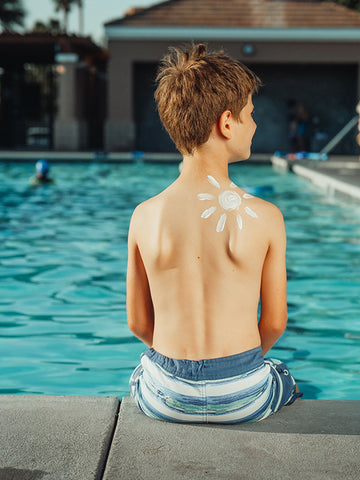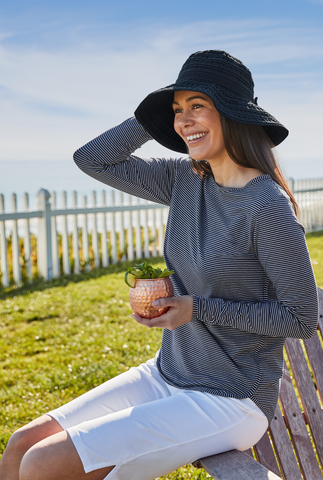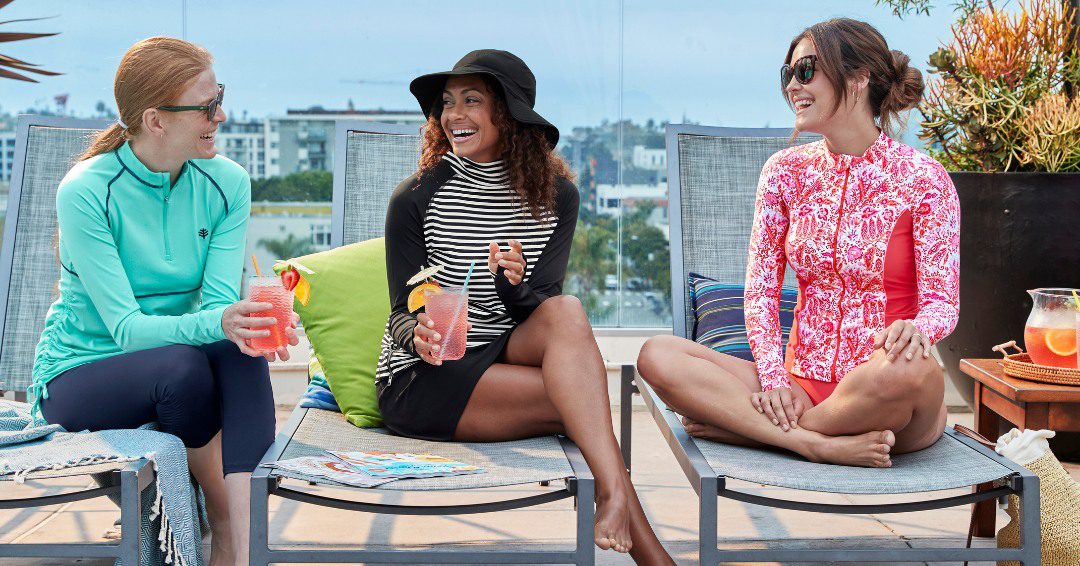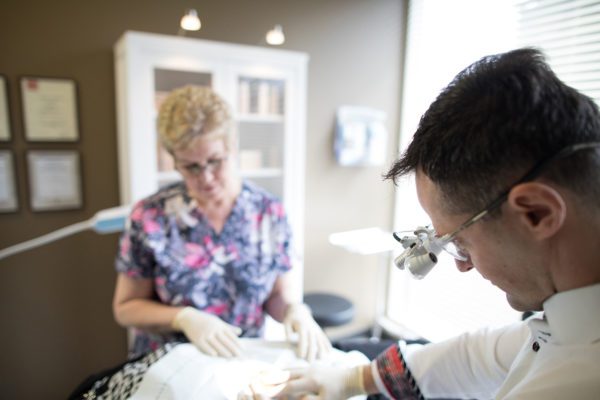The harmful effects of the sun’s ultraviolet (UV) rays have been well established in many studies. UV exposure leads to skin aging and is the leading cause of skin cancer. In order to prevent sun damage now and in the future, sun protection is necessary. One of the preferred methods of protection is uv protective clothing, which blocks or absorbs UV radiation. Highly effective in offering protection against sun damage, uv protective clothing is perhaps the easiest way to stay safe. We’ll conclude with what UPF clothing is & what to look for.
In this article, we’ll cover the harmful effects of UV rays and the different types of UV radiation. We’ll look at the ways to protect your skin from UV damage and where SPF fits in. We’ll take a brief look at how sunscreen works, how much you need and if it’s enough (spoiler: it’s usually not).
Let’s get started!
INDEX
- The Harmful Effects of UV Radiation
- Who Is Susceptible to Skin Cancer
- The Different Types of UV Radiation
- How to Protect Your Skin From UV Radiation
- How Sunscreen Works
- What Is SPF?
- How Much Sunscreen Should I Use?
- Is Sunscreen Enough?
- What Is Sun Protective UPF Clothing?
- What Is the Difference Between UPF and Regular Clothing?
- Difference Between UPF and SPF
- Things to Consider When Buying Sunscreen Clothing
- Ask the Professionals
THE HARMFUL EFFECTS OF UV RADIATION

Solar ultraviolet radiation (UVR) is the main environmental risk-factor for skin cancer. Being the most prominent carcinogen in our natural environment, our skin has evolved protective defense mechanisms. Melanin is a dark pigment in our epidermis (the outer layer of skin cells) that helps to protect our skin from UV rays. People tan because sunlight causes an increase in the production of melanin.
Melanin works by absorbing UV rays, shielding the more sensitive molecules in the skin. Melanin also has antioxidant and free-radical scavenging properties. Together, these properties help to protect DNA from damage and potential cancer-causing mutations.
There’s growing evidence that the relationship between pigmentation and UV protection is more complicated than we initially thought. This, along with the continual depletion of our ozone layer and a cultural obsession with being tanned, has led to an increase in UV-induced skin cancers.
WHO IS SUSCEPTIBLE TO SKIN CANCER
While our skin has natural protective mechanisms, these mechanisms aren’t enough to mitigate all the harmful effects of UV radiation. Basal cell & squamous cell cancers typically form on the body parts most exposed to the sun, such as the face, neck, hands and arms. Most cases of melanoma, the most dangerous kind of skin cancer, are due to exposure to UV radiation.
Though anyone can get skin cancer, it’s most common in people who spend a lot of time in the sun occupationally or have had sunburns in the past. It is most prominent in individuals who have light skin, hair and eyes. If you have had skin cancer already, your chances of getting it again are increased. Finally, individuals over the age of 50 are also most susceptible.
THE DIFFERENT TYPES OF UV RADIATION
UV radiation is classified into three main types:
- UVA – not absorbed by the earth’s ozone layer; weaker than UVB, but more constant throughout the year. UVA is commonly remembered as “A for Aging”, as prolonged UVA radiation is a causative agent of premature skin aging and many skin cancers. These rays penetrate deeper into the skin.
- UVB – mostly absorbed by the earth’s ozone layer; the strongest of the penetrating UV rays, this radiation is commonly remembered as “B for Burn” as it is associated with sun burns via short-term exposure.
- UVC – completely absorbed by the earth’s ozone layer; does not pose much of a risk as it doesn’t reach the earth’s surface.
Overexposure to UV radiation can lead to serious health issues. All types of UV radiation can cause DNA damage, which makes protecting your skin incredibly important.

HOW TO PROTECT YOUR SKIN FROM UV RADIATION
There’s a lot of preventative measures you can take to avoid the harmful effects of UV radiation. To protect your skin:
- Avoid the midday sun – UV rays are at their strongest from 10am to 4pm, even during cooler weather and especially at higher altitudes.
- Seek shade – regardless of the time of day, avoiding the sun wherever possible is the best way to protect your skin.
- Avoid tanning beds – no matter how advanced or safe they claim to be, tanning beds are a concentrated source of UV radiation; just one session in a tanning bed can significantly increase the risk of skin cancer.
- Wear a hat & glasses – sun hats and glasses that are full coverage and designed for UV protection are the best way to protect your face, neck, ears, eyes and head.
- Use protective coverings – UV umbrellas, shawls and blankets are a great way to provide an extra layer of protection.
- Wear uv protective clothing – UPF fabrics, which we’ll get into in further detail, go above and beyond regular fabrics in protecting you from UV radiation.
- Wear sunscreen – any exposed area should be protected with a broad spectrum SPF 30 or higher sunscreen; regardless of the SPF rating, reapplying frequently and in sufficient amounts is essential.
HOW SUNSCREEN WORKS
Sunscreen can be divided into two main categories based on active ingredients: physical and chemical. Both physical and chemical sunscreens are tested for their safety and efficacy, and many sunscreens use a combination of active ingredients.
PHYSICAL
Physical sunscreens, also known as mineral sunscreens, work by providing a physical barrier that blocks and reflects UV rays. Zinc oxide and titanium dioxide are the most common minerals used in physical sunscreens.
CHEMICAL
Chemical sunscreens work by absorbing UV rays before they can do damage to the skin. Common active ingredients include avobenzone and octisalate.
Many physical sunscreens are labelled as “natural” because they are mineral based. However, it’s important to note that mineral sunscreens use inorganic compounds and chemical sunscreens can use organic UV filters. This makes reading the ingredients list an important step in determining how natural a sunscreen actually is.
For most dermatologists, the best sunscreen is the one that you use consistently. One of our favourites at Kelowna Skin Cancer Clinic is Coola sunscreen, an environmentally-friendly, cruelty-free line made with organic botanical ingredients.

WHAT IS SPF?
SPF stands for sun protection factor. It is an estimate of how long it would take for UV rays to redden your skin when using the sunscreen exactly as directed. This is compared to the amount of time without any sunscreen. For example, using an SPF 50 sunscreen, it would take you 50 times longer to burn than if you weren’t wearing any sunscreen.
As the rating goes up, the percentage of UV rays that are able to pass through also slightly decreases. This makes a higher SPF rating, up to a certain point, more effective in protecting your skin than lower SPF alternatives.
Under perfect conditions, a broad-spectrum sunscreen with a high SPF offers great protection. However, sunscreen application is rarely perfect, which makes SPF ratings largely unreliable.
HOW MUCH SUNSCREEN SHOULD I USE?
Sunscreen protection depends on a uniform application with a sufficient amount of product. Most individuals only apply 25-50% of the recommended amount, which reduces the amount of protection they’re getting.
To add to this problem, only about one-third of individuals reapply every 2 hours or after outdoor activity. This decreases the efficacy of the product. Many sunscreens are also not photostable, which means they can start to degrade before their work even begins.
The amount of sunscreen required depends on product formulation. However, the Skin Cancer Foundation recommends at least 1 ounce, about the size of a shot glass, for a full-body adult application. For kids over 6 months, there’s no set amount as kids grow quickly. Rather, it is recommended to thoroughly cover all exposed areas.

IS SUNSCREEN ENOUGH?
Despite the common use of sunscreen to prevent UV sun damage, the prevalence of skin cancer continues to increase every year. Over 80,000 cases of skin cancer are diagnosed in Canada every year, with over 5,000 cases being melanoma.
With our inconsistent and infrequent use, sunscreen alone isn’t enough. Complete sun protection must include other measures, with sun protective clothing being one of the most effective.
WHAT IS UV PROTECTIVE CLOTHING?
UV protective clothing is a type of clothing that is made from ultraviolet (UV) blocking fabric. It is a specialized fabric that comes with an ultraviolet protection factor (UPF) rating. This rating indicates how much UV, including UVB and UVA, can pass through a fabric to reach the skin.
For instance, a fabric with UPF50 rating blocks 98% of the sun’s rays and allows just 2% to penetrate through. This lowers your UV exposure risk remarkably. A higher UPF rating provides the best protection:
- UPF 15 or 20 – Okay
- UPF 25, 30, or 35 – Good
- UPF 40, 50, or above – Excellent
WHAT IS THE DIFFERENCE BETWEEN UV PROTECTIVE CLOTHING AND REGULAR CLOTHING?
Do regular clothes actually protect us from the sun? Does simply donning a long-sleeved shirt or something similar prevent us from lasting damage from the UV rays of a powerful sun? The simple answer is no.
At the United States Cleveland Clinic, Alok Vij, M.D. said that regular cotton t-shirts typically amount to about a UPF of 5. That simply won’t cut it. The typical, loose-fitting clothing from our everyday wardrobe allows UV rays to penetrate the tiny holes in the fabric and is relatively useless against the sun. In the case of light-coloured shirts, UV can travel right through the fabric. Of course, as we suggested in an earlier blog, you could always start wearing darker clothing, but even then, you’re not out of the dark.
UV protective clothing provides you with the best protection, offering UPF numbers of 40, 45, and 50+. UPF clothing will endure testing at independent labs to ensure certain levels of protection from the sun. Ideally, for the best protection, tightly-woven synthetic materials, preferably in dark colors that cover your whole body.
THE DIFFERENCE BETWEEN UPF AND SPF
UPF refers to the amount of UV rays that can penetrate through a type of fabric to reach your skin. Whereas, SPF tells the time it takes for the skin to redden when exposed to UV radiation.
If you burn after 15 minutes, an SPF 15 sunscreen can safeguard your skin for a duration 15 times longer. However, it is important to remember this is a rough estimate. Efficacy depends on your skin type, the intensity of the sun and the amount of sunscreen used.

THINGS TO CONSIDER WHEN BUYING SUNSCREEN CLOTHING
In general, clothing protects against the sun. However, not all colours and fabrics offer the same level of protection. To shield your skin against sun damage, keep the following factors in mind when shopping for sun protective clothing:
- COLOUR: Dark coloured clothing prevents the sun’s UV rays from reaching your skin; instead of allowing it to pass through, they absorb these rays. This means that darker shades can offer better sun protection than lighter colours.
- CONSTRUCTION: Clothes like wool, canvas, and denim are densely woven, and can offer more protection than thin and loosely-woven garments. You can check sun safety of any fabric, simply by holding it against the light. If you can easily see through, it means UV rays can penetrate the fabric to reach the skin.
- FABRIC: The fabric of your clothing matters when it comes to sun protection. For example, unbleached cotton comprises lignin that can absorb UV radiation. Likewise, glazy polyesters and lightweight satin-like silks offer high levels of sun protection as they can reflect UV radiation. Advanced fabrics, treated with UV absorbing agents, also prevent UV rays from penetrating the fabric and reaching the skin.
- FIT: Loose-fit garments are more effective. The reason being, tight clothes can stretch, which lowers the degree of protection. Stretched fibres have more space between them, which can allow more UV rays to pass through.
- UPF: Many sun protective clothing companies manufacture apparel with UPF labels to indicate exactly how much UV the clothing can shield against.
- COVERAGE: The more skin the clothing covers, the more protected you will be. Always opt for wearing long-sleeve shirts, and long pants or skirts.
- ACTIVITY: If the garment you wear gets wet or stretched, it will lose some of its ability to protect you from the sun. The garment may become more transparent, making your skin more exposed to UV radiation. So, when you are swimming or engaged in some outdoor activity, take extra care to protect your skin.
ASK THE PROFESSIONALS
At Kelowna Skin Cancer Clinic, we’re love helping our patients, family and friends build sun-smart habits. We believe in the power of prevention and enjoying the outdoors safely. For more information on our preventative services and treatments, get in touch today!
References:
- Briceno et al. (2020) Parametric human modelling to determine body surface area covered by sun-protective clothing. Ergonomics, 63(3): 293-306.
- Grujl, F.R. (1999). Skin cancer and solar UV radiation. European Journal of Cancer, 35(14): 2003-2009.
- Brenner, M. and Hearing, V.J. (2009). The Protective Role of Melanin Against UV Damage in Human Skin. Photochem Photobiol. 84(3): 539–549.
- CDC Contributors (2021). UV Radiation. Centers for Disease Control and Prevention.
- EPA Contributors. Ultraviolet (UV) Radiation and Sun Exposure. United States Environmental Protection Agency.
- AAD Contributors (2018). 10 Surprising Facts About Indoor Tanning. American Academy of Dermatology Association.
- Skin Cancer Foundation Contributors (2021). All About Sunscreen. The Skin Cancer Foundation.
- Skin Cancer Foundation Contributors (2020). Ask the Expert: Does a High SPF Protect My Skin Better? Sun & Skin News. The Skin Cancer Foundation.
- Cole, C., Appa, Y., and Ou-Yang, H. (2014). A broad spectrum high-SPF photostable sunscreen with a high UVA-PF can protect against cellular damage at high UV exposure doses. Photodermatol Photoimmunol Photomed. 30(4): 212-9.
- World Health Organization (2002). Global Solar UV Index – A Practical Guide.
- RealSelf Contributors (2019). 2019 RealSelf Sun Safety Report: Only 1 in 10 Americans Uses Sunscreen Daily; Men Significantly More Likely Than Women to Reapply Sunscreen and Get Annual Skin Check.
- Gonzalez et al. (2007). Photostability of commercial sunscreens upon sun exposure and irradiation by ultraviolet lamps. BMC Dermatology. 7(1):1.




